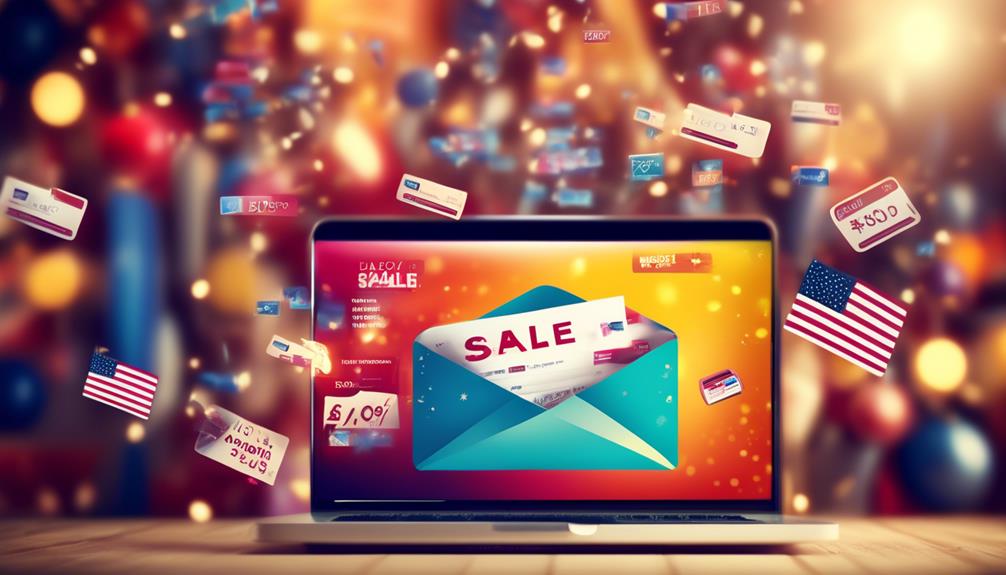Personalized Email Strategies
Subdomain for Email Marketing
Frustrated with email deliverability? Discover how a subdomain for email marketing can be a game-changer in improving your results.

Handling multiple domains might appear challenging, but integrating a subdomain into your email marketing strategy can truly transform the game.
The decision to separate your marketing emails from your main domain might seem daunting, but the benefits are worth considering. From improving deliverability to protecting your main domain’s reputation, the advantages of a subdomain for email marketing are significant.
So, how exactly does it work, and what are the best practices for implementation? Let’s explore the key considerations and steps involved in leveraging a subdomain for email marketing.
Key Takeaways
- Using a subdomain for email marketing can significantly impact sender reputation and email deliverability.
- Implementing best practices for subdomain usage, such as clear and descriptive subdomain names and proper DNS records setup, ensures optimal deliverability and higher engagement.
- Segregating the reputation of each subdomain can optimize engagement and deliverability for different types of email communications.
- Proper setup of email subdomains, including choosing relevant names and adding necessary DNS records, enhances deliverability and reputation.
What Is a Subdomain for Email Marketing?
We’ve all encountered subdomains in our web browsing experience, but what exactly is a subdomain for email marketing?
In the realm of email marketing, a subdomain is a domain prefix used to send and receive emails. By sending emails from a subdomain rather than the root domain, you can significantly impact your sender reputation and email deliverability. This is crucial for ensuring that your emails land in the recipient’s inbox and not in the dreaded spam folder.
Using a subdomain for email marketing allows for the separation of different types of emails, such as marketing and transactional emails. This separation is ideal for maintaining clarity and organization in your email sending practices. Additionally, it can be beneficial for monitoring and managing the reputation of your sending domain.
When setting up an email subdomain, it’s essential to follow best practices, including clear naming conventions and proper DNS record implementation. By doing so, you can effectively manage your email sending domain’s reputation and deliverability, ultimately maximizing the impact of your email marketing efforts.
Benefits of Using a Subdomain

Using a subdomain for email marketing offers several key benefits that can enhance your email deliverability and sender reputation. By separating your email campaigns or transactional emails onto a subdomain, you can isolate your email activity from your main domain, thereby protecting your domain reputation. This practice also allows for specific email authentication records to be set up, further boosting your sender reputation and email deliverability. Below, we’ve highlighted the benefits of using a subdomain for email marketing in a clear and concise manner:
Benefits of Using a Subdomain Enhanced Sender Reputation By isolating email activity, sender reputation is protected. Improved Email Deliverability Specific email authentication records can be set up, enhancing deliverability. Isolation of Email Activity Separating email campaigns from the main domain protects domain reputation.
Best Practices for Subdomain Usage
Best practices for subdomain usage involve implementing clear and descriptive subdomain names to effectively categorize different types of email communications and avoid confusion. When setting up email subdomains, it’s crucial to follow best practices to ensure optimal deliverability and higher engagement. Here are some essential best practices for using email subdomains:
- Clear and Descriptive Names: Choose subdomain names that clearly indicate the type of emails being sent, such as ‘marketing.yourdomain.com’ or ‘transactional.yourdomain.com’.
- Separate Sending Operations: Utilize separate subdomains for different types of email sending operations, such as cold outreach, follow-ups, and department-specific sending, to prevent deliverability issues and maintain a positive email reputation.
- Proper DNS Records Setup: Configure the necessary DNS records, including SPF, DKIM, and DMARC, for each subdomain to authenticate the emails and establish sender credibility with email providers.
Implementing Email Subdomains

After establishing best practices for subdomain usage, the next step is to implement email subdomains effectively to optimize deliverability and engagement.
When implementing email subdomains, it’s crucial to use a subdomain for each distinct purpose, such as separate subdomains for different types of email communications. For instance, a subdomain can be created for transactional emails, another for marketing emails, and yet another for customer support emails. This approach helps in segregating the reputation of each subdomain, ensuring that the engagement and deliverability of emails are optimized for their specific purposes.
Additionally, it’s important to ensure that the new domain or subdomains are aligned with the company’s privacy policy and branding. This means incorporating the necessary privacy policy and branding elements into the subdomains to maintain consistency and trustworthiness.
Moreover, when implementing email subdomains, it’s essential to configure the DNS records correctly to enable the subdomains to send and receive emails effectively. This includes setting up the appropriate SPF, DKIM, and DMARC records for each subdomain to authenticate the email sender and enhance email deliverability.
Setting up an Email Subdomain
We can enhance our email deliverability and reputation by setting up a dedicated subdomain for our email communications. When setting up an email subdomain, there are a few key considerations to keep in mind:
- Different Subdomains: It’s important to set up different subdomains for various types of email communications, such as marketing and transactional emails. This helps in maintaining a clear separation and ensuring that each type of email is sent from its own distinct subdomain.
- New Subdomain: When setting up a new subdomain for email purposes, it’s essential to choose a clear and relevant subdomain name to avoid any confusion. This will also help in establishing a strong identity for the email communications sent from that subdomain.
- Need to Add DNS Records: To use an email subdomain, it’s necessary to add the provided DNS records to the domain. After adding these records, verification is required, and MX records need to be added for receiving email at the subdomain.
Frequently Asked Questions
Should You Use a Subdomain for Email Marketing?
Yes, we should use a subdomain for email marketing. It helps in isolating business emails, managing deliverability, and adapting sender reputation initiatives.
Proper warming up, monitoring, and maintenance are crucial for success. Separate subdomains for different types of emails aid in investigation and faster problem-solving.
Categorizing email addresses becomes easier, and it’s valuable for transactional, promotional, and informational emails.
How Do I Create a Subdomain for Email Marketing?
Creating a subdomain for email marketing involves several steps:
- Log in to the Mailgun platform.
- Navigate to the ‘Sending’ section.
- Add a credit card if needed.
- Add the provided DNS records to your domain.
This process allows for the separation of marketing and transactional emails, making it easier to manage different types of email operations.
What Is an Example of a Subdomain Email?
An example of a subdomain email is newsletter.meowgun.com, used for marketing emails.
Proper warming up and monitoring are crucial for successful email deliverability. We ensure this by implementing proper authentication methods and monitoring performance.
This approach is essential for maintaining a positive sender reputation and maximizing email deliverability.
Are Subdomains Allowed in Email Addresses?
Yes, subdomains are allowed in email addresses. They enable organization and categorization of web content.
Additionally, they provide separate sending and receiving of emails, improving sender reputation and reducing risks.
Many businesses use separate subdomains for different types of emails, such as marketing, transactional, and informational.
Proper warming up, monitoring, and maintenance are essential for successful email deliverability when implementing and setting up an email subdomain.
Conclusion
In conclusion, using a subdomain for email marketing can significantly improve the deliverability and reputation of marketing emails.
By separating marketing emails from the main domain, businesses can better protect their brand and ensure that their emails reach the intended audience.
This best practice is recommended by email service providers for a reason – it has been proven to be effective in enhancing email marketing efforts.
Natali – Editor in Chief (Strategy and Mastery, AI Expert) Natali, our Editor in Chief, is the driving force behind our content’s strategic direction. With a keen eye for detail and a deep understanding of market trends, Natali ensures that our content is top-notch and strategically aligned with our client’s goals. Her expertise in AI helps to seamlessly integrate advanced technology into our marketing strategies, pushing the boundaries of conventional marketing.
Personalized Email Strategies
Email Marketing Strategies for Labor Day Shopping
Leverage the power of email marketing to drive sales during the Labor Day weekend and discover the key elements that can make your campaign a success.

As we get ready for the Labor Day weekend, it’s amazing to see the important role that email marketing strategies can play in increasing sales during this time. Our team has been exploring various strategies to take advantage of the holiday shopping frenzy and make the most of this significant retail event.
From leveraging exclusive discounts to incorporating patriotic themes, there are numerous strategies worth considering. But what truly sets apart a successful Labor Day email campaign?
Stay tuned to uncover the key elements that can elevate your marketing efforts and maximize sales during this holiday weekend.
Key Takeaways
- Incorporate Labor Day email subject lines that highlight the holiday’s significance to capture attention.
- Utilize Labor Day email templates that reflect the holiday’s significance to resonate with the audience.
- Personalize subject lines to grab customers’ attention and make them feel valued.
- Leverage seasonal themes and offers, such as patriotic colors and outdoor-related products, to tap into the spirit of Labor Day and summer vibes.
Understanding Labor Day’s Significance
Understanding the significance of Labor Day helps businesses craft more impactful and meaningful marketing campaigns that resonate with consumers’ values and priorities. Labor Day isn’t just a day off; it’s a celebration of the hard work and dedication of American workers. This understanding can be leveraged in Labor Day emails to connect with consumers on a deeper level, showcasing appreciation for the workforce and offering deals that honor their contributions.
By incorporating Labor Day email subject lines that highlight the holiday’s importance, businesses can capture attention and convey a message that goes beyond just sales. Labor Day email marketing strategies should aim to convey a sense of gratitude and recognition, aligning with the spirit of the holiday. Utilizing Labor Day email templates that reflect the holiday’s significance can help in creating campaigns that resonate with the audience.
Data shows that consumers are more likely to engage with marketing campaigns that reflect their values, making it crucial for businesses to infuse their Labor Day messages with authenticity and appreciation.
Crafting Impactful Email Campaigns

Crafting impactful email campaigns requires careful consideration of personalized subject lines to capture attention and stand out in crowded inboxes. By using vibrant and summer-themed content, a sense of urgency and desire for customers can be created. Incorporating phrases like “Labor Day Sale Ends” and “Early Access” can instill a fear of missing out (FOMO) and drive customers to make a purchase by emphasizing the limited-time offers. To tap into the patriotic spirit and connect with customers, it’s effective to utilize patriotic themes and colors. Additionally, countdown timers and optimized CTAs can be used to build urgency and improve engagement. When crafting Labor Day email campaigns, it’s crucial to incorporate these elements to make the campaign impactful and successful. Below is a table showcasing some Labor Day email examples:
Subject Line Content CTA “Last Chance for Savings” Summer-themed images and products on sale “Shop Now” “Exclusive Early Access” Patriotic color scheme and FOMO-inducing copy “Get Access Now” “Final Hours for Deals” Countdown timer and limited-time offer details “Shop Labor Day Sale” “Celebrate Labor Day” Back to school deals and patriotic imagery “Explore Deals”
These examples illustrate the elements of personalized subject lines, vibrant content, FOMO-inducing language, patriotic themes, and optimized CTAs that can make Labor Day email campaigns impactful and drive sales.
Engaging Subject Lines for Open Rates
As we pivot to discussing ‘Engaging Subject Lines for Open Rates’, let’s explore the pivotal role of personalized subject lines in capturing customers’ attention and driving open rates for Labor Day email campaigns.
- Personalization: Incorporate customers’ names or past purchase history in subject lines to grab their attention and make them feel valued.
- Data-driven personalization can increase open rates by up to 29.3%.
- A study by Experian found that personalized subject lines can generate 6 times higher transaction rates.
Emojis and Urgency: Utilize emojis to add visual appeal and convey emotions, and create a sense of urgency with phrases like ‘Limited Time Offer’ to drive customer action.
- According to a report by Experian, subject lines with emojis had a 56% higher open rate.
- Including a countdown timer in subject lines can increase the likelihood of customers opening the email by creating a fear of missing out.
Crafting engaging subject lines is a critical component of any successful Labor Day email campaign. By leveraging personalization, emojis, and a sense of urgency, businesses can significantly boost open rates and drive sales during the Labor Day shopping season.
Leveraging Seasonal Themes and Offers

With Labor Day approaching, our email marketing strategy will focus on leveraging seasonal themes and offers to captivate our audience and drive sales.
To align with the patriotic spirit of the nation, we’ll utilize red, white, and blue colors in our Labor Day email designs.
Additionally, we’ll tap into the summer vibes by using bright warm colors and promoting products associated with outdoor activities, creating a sense of urgency and desire for our customers.
Our Labor Day email campaigns will feature standard discount promo code deals, such as a percentage off or a specific dollar amount discount, effectively driving the message home and encouraging purchases.
To further incentivize customers, we’ll create a sense of urgency with limited-time offers, maximizing sales during the Labor Day weekend.
Moreover, we’ll target Back to School shoppers by highlighting school or college-related products in our email marketing campaigns, effectively tapping into this market segment.
Maximizing Sales With Strategic Timing
To maximize sales with strategic timing, our email marketing approach will focus on precisely targeting key moments leading up to and during the Labor Day weekend to prompt customer engagement and drive conversions. By leveraging the days leading up to Labor Day, we can promote special deals and discounts, creating a sense of urgency and encouraging increased sales.
Additionally, timing Labor Day emails to coincide with the start of the holiday weekend can tap into consumers’ readiness to spend, further boosting sales.
Key Strategies:
- Strategic Timing: We’ll strategically time the release of our emails to coincide with the peak shopping times during the Labor Day weekend to maximize customer engagement and drive sales.
- *Creating Urgency*: Implementing a well-timed email series that builds anticipation for the holiday sales will lead to increased customer interest and higher conversion rates, driving sales during this crucial period.
Frequently Asked Questions
What Are the 7 Email Marketing Strategies?
We’ve identified seven powerful email marketing strategies.
They include:
- Offering exclusive sneak peeks and early access to drive anticipation
- Using vibrant colors and vacation-themed promotions
- Incorporating countdown timers and limited-time offers
- Targeting Back-to-School shoppers
- Optimizing email subject lines
- Leveraging personalization and emojis
- Creating urgency.
These strategies are proven to engage subscribers, drive customer action, and enhance overall email marketing effectiveness.
Have a Great Labor Day Weekend Email?
We’ve crafted a compelling Labor Day weekend email that’s sure to grab attention. It’s packed with irresistible deals and exciting party ideas to elevate the holiday spirit.
Our email is designed to stand out in crowded inboxes, using vibrant colors and patriotic themes to evoke a sense of summer fun. With clear and urgent messaging, our email is driving purchases and delighting customers.
Get ready for an epic Labor Day weekend with our exclusive offers!
What Is an Effective Email Marketing Strategy?
We’ve found that personalization, urgency, and patriotic themes drive engagement and sales in email marketing. Using well-sequenced series and optimized subject lines is key.
Incorporating deals, party ideas, and savings can capture attention in crowded inboxes. Our approach focuses on maximizing customer engagement and driving action.
This data-driven strategy has proven effective in boosting sales and customer satisfaction.
What Kinds of Email Messaging Might Be Most Effective in Today’s Retail Environment?
We find that personalized, targeted messaging yields the most effective results in today’s retail environment.
By tailoring our emails to specific customer segments and providing relevant, valuable content, we can drive engagement and ultimately, conversion.
By leveraging data-driven insights, we can optimize our messaging to resonate with our audience and drive action.
This approach ensures that our email marketing efforts are both efficient and impactful.
Conclusion
In conclusion, by understanding the significance of Labor Day and crafting impactful email campaigns, we can effectively engage customers and drive sales.
Leveraging seasonal themes and offers, along with strategic timing, allows us to maximize the impact of our promotions.
With engaging subject lines and exclusive discounts, we can create a sense of urgency and excitement for customers.
By incorporating these strategies, we can make the most of the Labor Day shopping season and achieve our sales goals.
Natali – Editor in Chief (Strategy and Mastery, AI Expert) Natali, our Editor in Chief, is the driving force behind our content’s strategic direction. With a keen eye for detail and a deep understanding of market trends, Natali ensures that our content is top-notch and strategically aligned with our client’s goals. Her expertise in AI helps to seamlessly integrate advanced technology into our marketing strategies, pushing the boundaries of conventional marketing.
Personalized Email Strategies
Crm Email Marketing for Moving Company
Harness the power of CRM email marketing to guide your moving company's success and anchor customer loyalty.

As a relocation service provider, entering into the online realm may feel like exploring uncharted territory. However, with the right tools and strategies, CRM email marketing can act as a guiding light leading customers to your business.
But how exactly can email marketing steer your moving company towards success? Let’s explore the ways in which targeted email communication can not only connect with your audience but also anchor their loyalty to your brand.
Key Takeaways
- CRM email marketing enhances customer engagement and fosters loyalty, leading to increased customer satisfaction and retention.
- Choosing the right CRM for a moving company involves prioritizing scalability, seamless integration with email marketing tools, a user-friendly interface, comprehensive customer support, and robust lead management features.
- Implementing email automation for movers streamlines communication processes, saves time and resources, and enables personalized updates and offers, as well as advanced customer segmentation and retargeting.
- Best practices for email marketing include personalizing content and subject lines, segmenting email lists, conducting A/B testing, utilizing CRM data for personalized experiences, and continuously improving campaigns based on data-driven insights.
Benefits of CRM Email Marketing
Regularly employing CRM email marketing can significantly enhance customer engagement, drive website traffic, generate leads, and foster customer loyalty.
Through targeted email marketing campaigns, our CRM system enables us to connect with our customers on a more personal level, increasing their engagement with our brand and services. By delivering relevant and valuable content directly to their inboxes, we not only drive traffic to our website but also establish ourselves as a trusted source of information within the moving industry.
Furthermore, our CRM email marketing efforts have proven to be a powerful tool for lead generation and conversions. By strategically segmenting our email lists and tailoring our messages to specific customer personas, we can effectively nurture leads through the sales funnel, ultimately increasing our conversion rates.
Moreover, the use of our CRM system for email engagement has been instrumental in building and maintaining customer loyalty. By consistently delivering targeted and personalized communications, we strengthen our relationships with customers, leading to higher retention rates and customer lifetime value.
The measurable results and ROI provided by our CRM email marketing efforts further validate the significant benefits it brings to our business.
Choosing the Right CRM for Your Moving Company

In selecting the ideal CRM for our moving company, it’s essential to prioritize the following aspects:
- Scalability and Adaptability: We need a CRM that can scale and adapt to our company’s growth, accommodating our evolving needs.
- Seamless Integration: The CRM should seamlessly integrate with our current email marketing tools and software, ensuring a streamlined workflow.
- User-Friendly Interface: A user-friendly interface is crucial for smooth adoption and ongoing usage. It should be easy for our team to navigate and use the CRM effectively.
- Comprehensive Customer Support: We must prioritize a CRM that offers comprehensive customer support to address any issues or questions that may arise during implementation and usage.
- Robust Lead Management: The CRM should have robust lead management features specifically tailored to the moving industry. It should enable us to capture, nurture, and convert leads effectively.
- Real-Time Analytics: The CRM’s capability to provide real-time data and analytics is vital for informed decision-making and performance tracking. It should offer comprehensive analytics capabilities to help us evaluate our email marketing efforts.
Implementing Email Automation for Movers
To streamline communication processes and enhance customer satisfaction, our moving company will implement email automation for personalized and targeted customer engagement.
Implementing email automation for movers is crucial in the modern landscape of email marketing. It allows our company to send relevant and timely emails without manual intervention, saving time and resources while ensuring that our customers receive the information they need.
By leveraging email automation, we can provide personalized updates, moving tips, and relevant offers based on the customer’s stage in the moving process. This not only enhances customer satisfaction but also helps in retaining customer interest and preventing disengagement.
Additionally, the combination of email automation and CRM email tracking enables us to monitor customer actions, improve communication, and offer advanced customer segmentation and retargeting. This strategic approach not only saves time and effort in executing mass email campaigns but also ensures that our emails are targeted and impactful.
As a moving company, implementing email automation is a powerful tool for enhancing customer engagement and overall marketing effectiveness.
Best Practices for Email Marketing

Moving forward in our discussion, we’ll now focus on the best practices for email marketing, building on the importance of implementing email automation for movers to enhance customer engagement and satisfaction.
When it comes to email marketing for your moving company, following best practices is crucial for success. Here are some essential strategies to consider:
- Personalization: Tailor your email content and subject lines to individual customers, increasing open rates and engagement. Utilize your CRM system to gather customer data and create personalized experiences throughout the customer journey.
- Segmentation: Divide your email list into distinct customer groups based on demographics, behavior, or preferences. This allows you to deliver targeted and relevant content, enhancing the overall effectiveness of your email campaigns.
- A/B Testing: Experiment with different elements such as subject lines, visuals, and calls-to-action to determine the most effective combinations. Utilize data from A/B testing to optimize your emails and enhance performance.
Perks of Email Marketing for Moving Companies
Regularly, email marketing offers numerous advantages to moving companies, including increased brand visibility and customer engagement. By leveraging email marketing for moving, companies can effectively reach potential customers and stay top of mind throughout the moving process. Here are some key perks of email marketing for moving companies:
Perks of Email Marketing for Moving Companies Drives traffic to the company’s website, generating leads and conversions. Builds customer loyalty and retention. Provides measurable results and a high return on investment (ROI). Allows for personalized and targeted messaging. Increases brand visibility and customer engagement.
Implementing an email marketing strategy tailored to the needs of a moving company can significantly impact customer acquisition and retention. It enables personalized communication through the CRM system, fostering stronger relationships with potential customers. Additionally, email marketing for moving companies allows for the delivery of valuable and relevant content, positioning the company as a trusted advisor in the moving process. Overall, the perks of email marketing make it an essential tool for moving companies looking to thrive in a competitive market.
Frequently Asked Questions
Can CRM Do Email Marketing?
Yes, CRM can do email marketing.
It allows us to streamline communication processes and save time by integrating email marketing directly into our customer relationship management system.
This integration improves user experience through email automation, offers advanced customer segmentation and retargeting, and helps businesses improve customer communication and support through email tracking and automation.
The marketing benefits of using CRM email marketing are substantial and can significantly enhance our overall marketing strategy.
What Are the 7 Email Marketing Strategies?
Sure, email marketing strategies can include:
- Building an email list through pop-up forms.
- Crafting attention-grabbing subject lines.
- Designing engaging content with visuals.
- Segmenting the list for targeted campaigns.
- Setting up automated welcome emails and A/B testing.
These strategies can optimize email marketing efforts and improve engagement. By implementing these techniques, we can effectively reach our audience, drive conversions, and build strong customer relationships.
What Is CRM Strategy Email?
CRM strategy email involves leveraging customer data to personalize and tailor email content for improved engagement and conversions.
It focuses on building and nurturing long-term relationships through strategic email communication, delivering relevant and timely messages to the right audience, driving customer retention and loyalty.
How Can CRM Help in Managing Customer Emails?
CRM helps in managing customer emails by organizing and segmenting them based on preferences. This enables personalized and targeted email marketing campaigns for higher engagement and conversions.
Insights into customer interactions with emails provide better tracking and analysis of email campaign performance. Additionally, CRM allows for automation of email workflows, saving time and ensuring consistent communication with customers.
Conclusion
In conclusion, CRM email marketing is a game-changer for moving companies.
Did you know that email marketing has an average ROI of $42 for every $1 spent?
It’s a cost-effective way to drive results and engage with customers.
By implementing the right CRM, utilizing email automation, and following best practices, moving companies can see significant growth and success in their marketing efforts.
Don’t miss out on the benefits of email marketing for your moving company!
Natali – Editor in Chief (Strategy and Mastery, AI Expert) Natali, our Editor in Chief, is the driving force behind our content’s strategic direction. With a keen eye for detail and a deep understanding of market trends, Natali ensures that our content is top-notch and strategically aligned with our client’s goals. Her expertise in AI helps to seamlessly integrate advanced technology into our marketing strategies, pushing the boundaries of conventional marketing.
Personalized Email Strategies
Cold Email for Digital Marketing Agency
Tackling cold email outreach for a digital marketing agency requires finesse, creativity, and a personalized touch – discover the key strategies.

When it comes to cold emailing for a digital marketing agency, it is often compared to creating a perfect elevator pitch. The objective is to grab attention, spark interest, and ultimately, open the door for further conversation.
But how do we achieve this in a way that feels genuine and not pushy? Let’s explore some effective strategies and best practices that can elevate our cold email outreach game and lead to meaningful connections with potential clients.
Key Takeaways
- Crafting a compelling subject line is crucial for capturing attention in cold emails.
- Personalization is key in engaging the recipient and showing understanding of their business.
- Clearly communicate the benefits of your offer to the recipient to increase their interest.
- Utilize targeted email lists and customize subject lines to grab attention and tailor outreach to specific audience segments.
Crafting Effective Cold Emails
Crafting Effective Cold Emails involves capturing attention with a compelling subject line and creating a personalized introduction to genuinely engage the recipient. In a cold email outreach campaign for a digital marketing agency, the subject line is our first opportunity to make an impression. It should be concise, relevant, and pique the recipient’s interest.
Personalization is key; addressing the recipient by name and showing an understanding of their business adds a human touch. When crafting your cold email, it’s crucial to clearly communicate the benefits for the recipient. Tailor the content to resonate with the target audience, demonstrating how your services can address their specific needs. Additionally, incorporating a call-to-action prompts the recipient to take the next step.
Ending with a personalized salutation and a unique email signoff helps in leaving a lasting impression. Throughout the cold email campaign, maintaining a professional tone and adhering to good email etiquette is essential. By following these strategies, the email strategy becomes more effective, fostering genuine engagement with the target audience.
Tips for Writing Cold Emails

When aiming to master the art of cold email outreach for a digital marketing agency, the key lies in understanding and implementing effective tips for writing engaging and personalized emails.
Craft a compelling subject line that grabs attention and encourages recipients to open the email.
Personalize the introduction to show genuine interest in the recipient and address their pain points.
Clearly communicate the benefits of your offer to the recipient to encourage engagement.
Follow good email etiquette, including a clear call-to-action and personalized salutation.
Use Email Marketing Software to personalize and automate your outreach, making it more efficient.
Leverage social media and blog posts to provide valuable content that showcases your expertise.
Include case studies to demonstrate successful outcomes and build credibility.
Finally, use a unique email signoff to leave a memorable impression and keep the email professional.
Examples of Cold Email Outreach
In our recent cold email outreach, we customized the subject line to grab attention and spark interest, compelling recipients to open our email and engage with our digital marketing services. To effectively grab the attention of the audience, we employed the following strategies:
- Utilized personalized Cold Email Templates: We crafted personalized cold email templates that addressed the specific needs and pain points of the recipient’s Company, showcasing how our software and Marketing Services could provide value.
- Highlighted the benefits: We clearly communicated the benefits of our services, emphasizing how we could improve their sales cycle, increase website traffic, and optimize Landing pages to drive conversions.
- Leveraged targeted email lists: We segmented our email list and tailored our outreach to specific audience segments, ensuring that our emails were relevant and resonated with the recipients.
Maximizing Outreach Efforts

To maximize our outreach efforts, we continuously refine our approach by tailoring our messages to the specific needs and interests of our recipients, incorporating personalized details such as first names and company names to establish a connection from the first point of contact.
When it comes to cold emailing, personalization is key. We focus on delivering value to the prospects’ inbox rather than a hard sell. By showcasing our expertise in areas like software development, landing page optimization, and SEO to grow small businesses, we aim to pique their interest and start a meaningful conversation.
Additionally, leveraging platforms like LinkedIn allows us to connect with prospects on a more personal level, further enhancing our outreach efforts. Utilizing social proof and examples of past successes helps build trust and credibility.
We constantly track our reply rate and adjust our approach as needed to ensure our email campaigns are effective. Sending follow-up emails is crucial to maintaining engagement and demonstrating our continued interest in helping prospects achieve their marketing goals.
Best Practices for Cold Email Strategy
Implementing a personalized and value-driven approach is essential for an effective cold email strategy in digital marketing. To achieve success, we recommend the following best practices:
- Craft Compelling Subject Lines:
- Use intriguing and personalized subject lines to increase open rates.
- Incorporate the recipient’s company name or reference to their work for a tailored approach.
- Avoid generic or salesy subject lines that may trigger spam filters.
- Personalize Emails:
- Address the recipient by their first name to establish a connection.
- Tailor the opening line to each recipient, demonstrating that the email is specifically crafted for them.
- Showcase expertise and experience to build credibility and trust.
- Follow Up Strategically:
- Send follow-up emails spaced out to avoid being pushy.
- Highlight the unique value proposition and how your agency’s SEO services can benefit the recipient.
- Include examples of successful campaigns or case studies to showcase past results and build trust.
Frequently Asked Questions
How Do You Write a Cold Email for Digital Marketing?
We write a compelling cold email by capturing attention with a strong subject line.
Personalizing the introduction to show genuine interest is also important.
We also make sure to clearly communicate the benefits of our digital marketing services.
Following proper email etiquette is crucial as well.
This includes including a clear call-to-action and personalized salutation.
Using a unique signoff and maintaining a professional tone throughout the email is crucial.
All of these elements help us craft an engaging and effective cold email for digital marketing.
How Do You Write a Cold Email for Smma?
We write a cold email for SMMA by using a catchy subject line, personalizing the email, and clearly communicating the benefits of our digital marketing services.
Our approach emphasizes genuine interest and connection with the recipient. By showcasing successful case studies and tailored strategies, we demonstrate the value we can bring to their business.
This personalized, benefit-focused approach is key to capturing attention and generating leads for our SMMA.
How Do I Write an Email for Digital Marketing?
We write an email for digital marketing by:
- Crafting a compelling subject line that resonates with the recipient.
- Personalizing the message to demonstrate genuine interest in their business.
- Clearly articulating the benefits of our digital marketing services.
We ensure good email etiquette by:
- Including a clear call-to-action and personalized salutation.
- Maintaining a professional tone.
- Using a unique email signoff.
This approach helps us effectively engage and convert potential clients.
Is Cold Emailing Illegal?
Cold emailing isn’t illegal when done in compliance with anti-spam laws and regulations. It can be legal if recipients have given consent or there’s a prior business relationship.
Understanding and following the CAN-SPAM Act guidelines is crucial for lawful cold emailing. It’s important to utilize opt-out mechanisms and honor unsubscribe requests.
Compliance with data privacy laws is essential in cold emailing to ensure legality and respect for recipients’ rights.
Conclusion
In conclusion, crafting effective cold emails is essential for a digital marketing agency to stand out in a crowded inbox.
By personalizing the intro, clearly communicating the benefits of our services, and following good email etiquette, we can maximize our outreach efforts and ultimately grow our client base.
Let’s paint a vivid picture of success with every cold email we send, capturing the attention of potential clients and driving results.
Natali – Editor in Chief (Strategy and Mastery, AI Expert) Natali, our Editor in Chief, is the driving force behind our content’s strategic direction. With a keen eye for detail and a deep understanding of market trends, Natali ensures that our content is top-notch and strategically aligned with our client’s goals. Her expertise in AI helps to seamlessly integrate advanced technology into our marketing strategies, pushing the boundaries of conventional marketing.
-

 Email Marketing1 month ago
Email Marketing1 month agoThe Convergence of Email and Chat: Integrating Messaging Platforms in Your Strategy
-

 Email Marketing1 month ago
Email Marketing1 month agoHyper-Personalization: Using Big Data to Create 1:1 Email Experiences
-

 Email Marketing1 month ago
Email Marketing1 month agoPredictive Analytics in Email Marketing: Anticipating Subscriber Behavior
-

 Email Marketing2 months ago
Email Marketing2 months agoThe Psychology of Color in Email Templates: Choosing the Right Palette
-

 Email Marketing3 months ago
Email Marketing3 months agoHow to Set Up a Dedicated IP for Your Email Campaigns
-

 Email Marketing3 months ago
Email Marketing3 months agoMobile-Optimized Emails: Technical Best Practices for Responsive Design
-

 Email Marketing2 months ago
Email Marketing2 months agoStorytelling in Email Marketing: Crafting Compelling Narratives
-

 Email Marketing2 months ago
Email Marketing2 months agoHow to Create ADA-Compliant Email Templates











